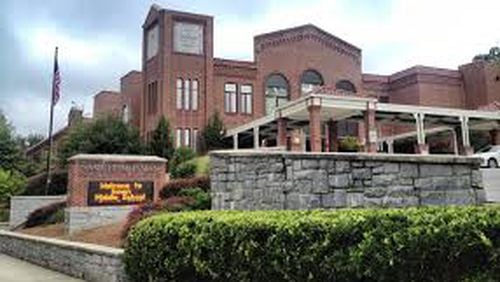APS remains a tale of haves and have-nots, demonstrated by high-performing and booming schools in Buckhead, Midtown, Virginia-Highland and Morningside and under-capacity schools, even in gentrifying east Atlanta where Superintendent Meria Carstarphen wants to close Benteen and Whitefoord elementary schools.
Benteen's 310 students would go to D.H. Stanton, while Whitefoord's 272 students would divide between Burgess-Peterson and Toomer elementaries.
At a meeting Monday night about the proposal, puzzled community members cited the surge in young families with toddlers in strollers. Why would APS shut down schools with an obvious baby boom underway?
Because those young middle-class families aren't choosing the neighborhood schools, opting for charters or private schools, said Carstarphen. Today, about 10,000 out of Atlanta's 52,000 students attend charters, she said. Two of the top charter schools in the metro area, Drew and Atlanta Neighborhood Charter, are in this community.
Some parents suggested APS redraw the entire district to rezone students from overtaxed classrooms in affluent neighborhoods to empty seats in southeast Atlanta, creating more socio-economically diverse schools in the process. Parents in those higher-income communities, many of whom bought their homes because of Inman Middle, North Atlanta High or Morningside Elementary, would resist any such effort, as they've done in the past.
Education researcher and forensic accountant Jarod Apperson, who writes the data-rich Grading Atlanta blog, agrees more balance is ideal, "but it is best achieved with marginal adjustments that move kids into desirable schools, rather than moving families to less desirable schools."
His suggestion: Open a test-based citywide gifted and talented K-12 school similar to New York's Stuyvesant High School and Anderson School.
“This would free up some seats in the North Atlanta and Grady clusters. I think you get a lot further this way than rezoning people from a desirable school to an undesirable one, in hopes that their presence will cause quality improvement. High-income people have options, and they exercise those options,” said Apperson. “Even if you could get them to stay, I think the capacity of a few high-income parents to turnaround a struggling school is probably overstated. Principals and teachers are much more important.”
Carstarphen says the merged elementary schools will end up with talented leaders and teachers armed with better and more resources. Still, with all the new families, why didn't schools in east Atlanta see a surge of interest and a rise in performance?
That’s a complicated question that touches on the role of charters in drawing away more capable students and committed parents and leaving behind the hardest-to-educate children and least-able-to-advocate families.
East Atlanta is home to Drew, which earns not only APS funding but corporate donations and sponsorships. As with the popular Atlanta Neighborhood Charter, Drew stands as both a star and a drain in APS, attracting motivated families willing to navigate a lottery process.
As one parent told me in an email, “I wish it was possible to be critical of the frustrations and tensions Drew creates in these communities without it seeming critical of what they’ve done. They’ve no doubt done tremendous good for a lot of kids. But there is a growing sentiment in these areas that the mission that they were chartered for has largely been achieved. Admitting more kids from East Lake and Kirkwood, largely from comfortable two-degree households, with a Subaru in the driveway, and a Labrador curled up in the open-concept family room, is no longer helping to break the cycle of poverty and education that they set out to confront.”
Today, only half the students in Charles R. Drew Charter School Elementary Academy quality for free and reduced lunch, according to the 2016 state Report Card. (In 2011, 74 percent of students were economically disadvantaged.)
"As far as Drew goes, yes the school has seen its population change dramatically in recent years. My understanding is that the Drew board requested the ability to use weighted lotteries -- a recently approved law now allows charters to give a greater chance of admission to students who are low-income or otherwise disadvantaged -- as a part of its recent charter renewal," said Apperson
The obvious response is to improve traditional public schools, so they, too, will enjoy the appeal of a Drew. But Carstarphen told me Burgess-Peterson Academy has done that, boasting similar achievement levels to Drew. Yet, Burgess-Peterson has not seen the uptick in enrollment she expected.
Apperson believes time will show an upswing at Burgess-Peterson, explaining, "These things are not immediate, but I believe parent perception of the school is decent, which over time should lead to greater buy in. It does seem there is room for buy-in and satisfaction in this corner of APS to continue improvement. If you look at Toomer particularly, some of the families that gave it a chance in 1st and 2nd grade are not around now that their kids are in 5th grade. It's tough to know the range of factors that drive these choices. I'm sure some parents left because they weren't fully satisfied and/or thought another option would be better for their kid. Others may have been motivated by a sense that middle school was approaching and they weren't confident in King {middle school}."
The superintendent acknowledged the historic roles of race and politics in consolidating some schools in poverty while insulating others. But Carstarphen said rectifying those past wrongs can’t overshadow the urgent need to improve schools for the children in them now.
"I support these consolidations for a couple of reasons I highlighted last year when discussing the district turnaround strategy," said Apperson. "First, APS doesn't have enough leadership capacity to run so many small schools. I think with fewer schools under management, it helps APS ensure higher-quality leadership. Second, it is a tough thing for a superintendent to recommend a school consolidation. It inevitably causes temporary friction. So, it takes some courage to make a recommendation like this, and I try to support courageous leadership when it seems sensible. I tend to frown on environments where leadership decisions are primarily motivated by an interest to not ruffle feathers."







